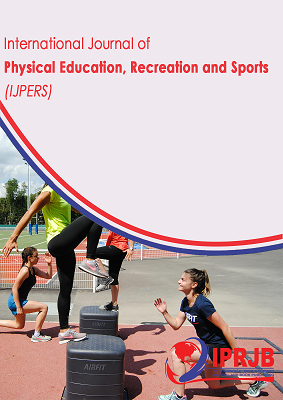IPRJB Main Navigation
Journals Navigation

Paper Submission:
Please use the following guideline to prepare your paper, then send it to journals@iprjb.org
Publication Cost:
The publication charge of this journal (online publication only) is
ISSN: 3005-6454
DOI: 10.47604/ijpers.
Impact Factor: 3.2
Index of this journal:
The mission of the International Journal of Physical Education, Recreation and Sports is to provide a platform for global scholars, educators, and practitioners to publish high-quality research that advances the fields of physical education, recreation, and sports. The journal aims to foster dialogue and innovation through scholarly articles that explore physical activity, wellness, sport management, and related policies.
The International Journal of Physical Education, Recreation and Sports maintains the credibility of its articles by implementing a rigorous double-blind peer review process. This ensures that all manuscripts are reviewed by independent experts in the field, upholding the integrity and quality of the published research.
Yes, the International Journal of Physical Education, Recreation and Sports is an open-access journal. This means that all articles published in the journal are freely available to anyone, anywhere in the world, increasing the visibility and impact of the research.
The International Journal of Physical Education, Recreation and Sports is a preferred choice due to its high-impact, open-access model, affordable publication fees, and its fast, transparent peer-review process. The journal is indexed in reputable databases, ensuring that your research reaches a global audience with a significant impact.
The publication fees for the International Journal of Physical Education, Recreation and Sports are designed to be affordable. The journal offers discounted fees for authors from developing countries, ensuring that researchers from diverse backgrounds can publish their work without financial barriers.
Submitting to the International Journal of Physical Education, Recreation and Sports provides your research with international exposure by indexing articles in well-known databases like Google Scholar, Crossref, and EBSCOhost. This ensures that your research reaches a global audience, enhancing its impact and citation potential.
The journal accepts original research articles, review articles, and case studies on various topics related to physical education, recreation, and sports. It encourages submissions on health and wellness, sport management, psychology, and policy studies in the field.
From submission to publication, the process typically takes between 4 to 6 weeks. This includes the peer-review process, revisions, and final approval, ensuring timely and efficient publication while maintaining high scholarly standards.
The International Journal of Physical Education, Recreation and Sports fosters inclusivity by offering affordable publication fees, especially for authors from developing countries. This ensures that researchers from diverse socio-economic backgrounds have the opportunity to publish their work in a prestigious journal.
What sets the International Journal of Physical Education, Recreation and Sports apart is its open-access model, affordable fees, and its strong commitment to rapid yet thorough peer review. The journal is indexed in top databases, enhancing visibility for authors and offering a global platform for impactful research in physical education, recreation, and sports.
Once your manuscript is submitted, you will receive timely updates via email about the status of your submission, including whether it has been accepted, rejected, or if revisions are required. This clear communication ensures that you are always informed about your manuscript’s progress.
Yes, early-career researchers benefit from the International Journal of Physical Education, Recreation and Sports’ low-cost publication fees, clear submission guidelines, and a transparent peer-review process. Additionally, they have the opportunity to gain international exposure and recognition for their work.
Each article published in the International Journal of Physical Education, Recreation and Sports is assigned a unique Digital Object Identifier (DOI), ensuring persistent citation and easy access to the research. The DOI helps your work remain accessible and citable long after publication.
The journal uses a double-blind peer-review process, where both authors and reviewers remain anonymous. This promotes impartiality and ensures that the published research maintains high academic integrity. The peer-review process is carefully managed to guarantee transparency and fairness.
Publishing in the International Journal of Physical Education, Recreation and Sports allows you to contribute to an open-access platform that is highly regarded in the field. With fast publication, affordability, wide global reach through indexing, and recognition in the academic community, this journal is an excellent choice for researchers looking to make a meaningful impact in physical education, recreation, and sports research.
IPRJB Main Navigation
Journals Navigation